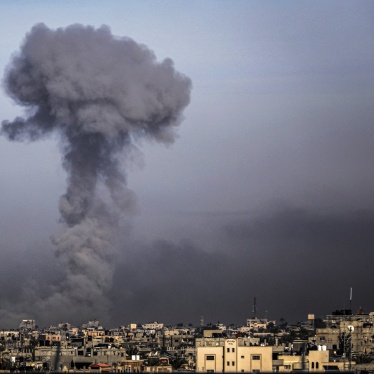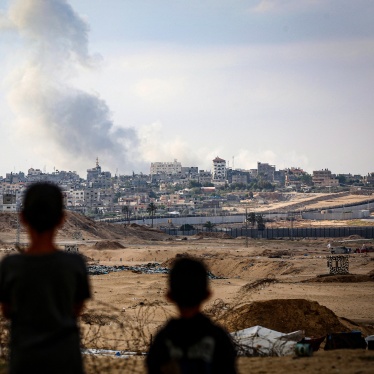Thank you Mr. President.
The past decade of CCW discussions and negotiations on cluster munitions boil down to this: a draft protocol that will do more humanitarian harm than good, and therefore should not be adopted. This protocol is likely to lead to an increase in the use of cluster munitions known to cause unacceptable harm to civilians. It is likely to lead to increased civilian casualties, and increased socio-economic devastation. We hear “something is better than nothing,” but something bad is not better than nothing.
The draft protocol provides explicit legal authorization for use of the vast majority of cluster munitions in the world’s stockpiles. By offering a specific legal blessing to the use of millions of cluster munitions containing hundreds of millions, perhaps billions, of submunitions, the protocol will facilitate use of those weapons. It will provide both legal and political cover for those who insist on using weapons that have already caused so much civilian suffering.
We hear that the protocol is important because it will apply to 85 to 90% of global stocks, those not covered by the Convention on Cluster Munitions. This percentage is at best a guesstimate that has not been backed up by actual data, and is being used to obscure the fact that the protocol will allow ongoing, unfettered use of an estimated two-thirds of those stocks, the ones produced after 1980. That kind of “coverage” we can do without. We will have more to say on the 90% figure and the 1980 date in a moment.
In addition to the protocol endangering civilians, it endangers international humanitarian law. Never before have states adopted a lower humanitarian standard in an international instrument after a higher standard has already been enacted – in this case a much higher standard, one agreed by a majority of the world’s nations. This regression in international humanitarian law is a terrible precedent to set, especially since in recent decades we have witnessed a positive trend of ever greater protection for civilians under IHL.
It is worth looking more closely at some of the key arguments put forth in favor of the draft protocol.
We hear: the protocol is the only way to have binding rules for the major users, producers, and stockpilers of cluster munitions. First, this point ignores that many of the big users, producers, and stockpilers of recent decades have already joined the Convention on Cluster Munitions, including France, Germany, the Netherlands, and the United Kingdom. Second, the binding rules contained in the draft protocol are so weak and riddled with exceptions, exemptions, and loopholes, that they will not, on balance, have a positive humanitarian impact. Third, at least in the case of the United States, and perhaps others, the protocol will not require it to do anything that is not already required by its existing national policy. Indeed, the protocol is considerably less demanding than current US policy and would allow the US to keep and use cluster munitions that are already designated for complete prohibition. Fourth, the Mine Ban Treaty has shown that the stigma against a weapon comprehensively banned has a powerful influence even on non-States Parties—certainly more so than weak, permissive international rules.
We hear: the prohibition on use of cluster munitions produced before 1980 will have an extensive and immediate humanitarian impact. This prohibition may apply to a large number of stockpiled cluster munitions (though we do not really know since only the US has provided numbers), but that does not mean it will have a significant impact on the ground, in offering greater protections to civilians. Surely most of these 30-plus-year-old munitions have reached or are about to reach the end of their shelf-life and will have to be withdrawn from service, with or without a protocol. More important, states will still have the bulk of their stocks (those produced after 1980) available for use, and those are the cluster munitions that the militaries are more likely to use, with or without a protocol. And most important, the post-1980 cluster munitions are not “life-saving” or “safe” cluster munitions. It is well-documented that those cluster munitions—with or without a safeguard mechanism—cause unacceptable harm to civilians.
We hear: 85 to 90% of the world’s stocks will be covered by the protocol, not by the Convention on Cluster Munitions. We have asked repeatedly how that percentage is arrived at, when no one can seem to even venture a guess at the size of the stockpiles of Russia, China, India, Pakistan, Israel, South Korea, or others. And beyond the size of the stock, no one knows how many of those cluster munitions would be affected by the protocol. It is a statistic without any known basis, and without any quantifiable meaning. But even more to the point, as we noted earlier, the vast majority of whatever the percentage is will still be eligible for use under the protocol.
By the way, the US stated yesterday it would have to ban 100 million submunitions claiming that is more than all Oslo states. But Oslo states had a combined stockpile closer to 200 million submunitions, of which more than 60 million have already been destroyed.
We hear: the exemption for cluster munitions with a failure rate of less than 1%, and the exception for cluster munitions with one safeguard are justified on technical and humanitarian grounds. These arguments should fall on deaf ears for the 76 (that is two-thirds of) CCW States Parties that are party to or signatories to the ban convention. Such provisions were thoroughly considered and rejected during the Oslo negotiations.
We hear: a transition period is needed to meet military requirements and to attract adherents. But it is impossible to square the mandate of urgently addressing the problem, and the rhetoric of immediate humanitarian impact, with any transition period, much less one of 12 years. Outside of this room, it is unlikely anyone could understand how CCW States Parties have decided some cluster munitions are so dangerous they must be banned, but then allow ongoing use for 12 years.
We hear: the protocol is vital to the credibility of the CCW, and this important international instrument must be bolstered. But the CCW’s credibility and reputation will be damaged, not strengthened by a weak, regressive protocol that will be widely viewed as pandering to the interests of a few big states, as backtracking on the comprehensive ban and the norm it is establishing, and as setting a dangerous precedent in international humanitarian law.
In conclusion Mr. President, the general statements over the past two days have left no doubt that there is nothing remotely resembling consensus on the draft protocol. Vast differences remain, and we cannot see any easy fixes. Certainly a band-aid approach like the endeavor clause—devoid of substance—will not bridge gaps. States Parties should be thinking even now about a Plan B if negotiations remain deadlocked, and we again point to the MOTAPM precedent of a political declaration.
Delegates should not underestimate the general public’s outrage at the possibility of adoption of a new law explicitly allowing use of cluster munitions. An online petition initiated last Thursday by the online advocacy community AVAAZ calling on states not to adopt the protocol garnered more than 270,000 signatures in less than 24 hours. As of this morning, it had well over half a million signatures from nearly every country, with large numbers signing from Germany, the United Kingdom, France, and Australia, as well as the US and Brazil.
The world is definitely watching, and the stakes are high –both for civilian populations in wartime and for international law. Outside this room, the “center of gravity” shifted long ago to reject this weapon. It’s time for the CCW to catch up with the reality that cluster munitions are already prohibited. The Cluster Munition Coalition implores you not to step back from the widely accepted and already wildly successful comprehensive ban on cluster munitions.
Thank you.







